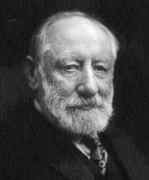Person: Franklin (2), Fabian

Fabian Franklin was a Hungarian born American mathematician who worked on combinatorics. He was married to Christine Ladd-Franklin.
Mathematical Profile (Excerpt):
- Franklin was educated in Washington, D.C. He won a scholarship to Columbian College in 1864 when he was eleven years old and the then new elective system allowed him to graduate in 1869 with the degree of Ph.B. This college had been set up in 1821 after the U.S. Congress had granted it a charter to be a "non-denominational College in the District of Columbia".
- When Franklin studied there the College was just restarting after the Civil war when it had been used as a hospital and military barracks.
- After graduating from Columbian College, Franklin worked as an engineer and a surveyor for the Pittsburgh and Connellsville Railroad.
- This was the first of Franklin's three different careers.
- Despite working as a surveyor for seven years, Franklin always wanted to study mathematics at university since mathematics was the subject for which he had a great passion.
- The fact that Franklin was working in the City Surveyor's Office in Baltimore when Johns Hopkins University opened was a very fortunate coincidence.
- This led to the second of Franklin's three careers.
- Franklin was appointed as a Fellow at Johns Hopkins and joined the university in the autumn of 1877, one year after the university opened.
- Franklin attended courses at the university and also participated in the Mathematical Seminar run by Sylvester.
- in 1878, when Sylvester was hard at work on his main contribution to the inaugural volume of the 'American Journal of Mathematics', he undoubtedly exposed Franklin and his other listeners to his evolving ideas on the interrelations between invariant theory in algebra and the atomic theory in chemistry by punctuating his lectures, as usual, with open questions and unverified conjectures.
- Franklin's first paper, published in the second part of this first volume of the American Journal of Mathematics in 1878 was the 25-page paper Bipunctual Coordinates.
- This paper formed Franklin's Ph.D. thesis and he was awarded his doctorate in 1880.
- However, let us go back to 1878 when Franklin was really undertaking two roles at Johns Hopkins.
- Franklin's second paper, published in the fourth part of the first volume of the American Journal of Mathematics in 1878, was On a Problem of Isomerism.
- It is an important paper for here we see Franklin beginning his research into partitions of integers, the topic for which he is most often remembered today.
- In this paper Franklin gave a different, and simpler, proof of a result on partitions that Sylvester had just published.
- Franklin would publish a number of papers giving clever proofs of existing theorems over the following years.
- Another thing to note about the Note on Partitions is Franklin's use of generating functions, another topic he returned to several papers.
- The next papers that Franklin published came from the work he did acting as Sylvester's assistant.
- These were Tables of the Generating Functions and Groundforms for the Binary Quantics of the First Ten Orders (1879) and Tables of the Generating Functions and Groundforms for Simultaneous Binary Quantics of the First Four Orders, Taken Two and Two Together (1879), both joint papers by Franklin and Sylvester.
- The next paper, although single authored by Franklin, still looked at this topic.
- In 1879 Franklin had been given an assistantship at Johns Hopkins and the assistantship was renewed for the academic year 1880-81.
- We saw from the quote above that both Franklin and Ladd attended Sylvester's number theory course.
- Franklin was about five years younger than Ladd but the two soon became close friends.
- Let us return to Sylvester's number theory course which both Franklin and Ladd attended.
- As he had done earlier, Franklin came up with a brilliant new idea about Sylvester's lectures.
- This paper brought Franklin international acclaim.
- Mr Halphen, one of our most eminent young mathematicians, who has just won the Academy's Grand Prix in mathematics, found Franklin's method so remarkable that he lectured on it in one of the most recent sessions of the Philomathic Society.
- Please tell Mr Franklin that his talent is appreciated, as it deserves to be, by the mathematicians of the old world.
- Franklin went on to publish many other papers, such as (with J J Sylvester) A Constructive Theory of Partitions, Arranged in Three Acts, an Interact and an Exodion (1882), (with P A MacMahon) Note on the Development of an Algebraic Fraction (1983/84), Proof of a Theorem of Tchebycheff's on Definite Integrals 91885), Two Proofs of Cauchy's Theorem (1887), Some Theorems Concerning the Centre of Gravity (1888), Note on the Double Periodicity of the Elliptic Functions (1889), Note on Induced Linear Substitutions (1894), and Note on Linear Differential Equations with Constant Coefficients (1897).
- Having been promoted to associate in 1882, associate professor in 1887 and professor in 1892, Franklin gave up his professorship in 1895 to begin the third of his three careers, namely as a journalist and author.
Born 18 January 1853, Eger, Heves County, Hungary. Died 9 January 1939, New York, New York, USA.
View full biography at MacTutor
Tags relevant for this person:
Origin Hungary
Thank you to the contributors under CC BY-SA 4.0! 

- Github:
-

- non-Github:
- @J-J-O'Connor
- @E-F-Robertson
References
Adapted from other CC BY-SA 4.0 Sources:
- O’Connor, John J; Robertson, Edmund F: MacTutor History of Mathematics Archive
